Characteristics of Surface Deformation in Lanzhou with Sentinel-1A TOPS
Abstract
:1. Introduction
2. Data and Methods
2.1. Study Area
2.2. Data Sources
2.3. Methods and Processing
2.3.1. SBAS-InSAR Algorithm
2.3.2. PS-InSAR Algorithm
2.3.3. Mann–Kendall Test
3. Results and Analysis
3.1. Validation of the Results
3.2. Spatial Distribution of the Surface Deformation
3.3. Time-Series Land Surface Deformation Map
3.4. Mutation Analysis of Surface Deformation for Regions P1−P7
4. Discussion
4.1. Relationship between Land Surface Deformation and Geology
4.2. Surface Deformation in Relation to Geological Faults
4.3. Surface Deformation in Relation to Land Cover/land Cover Changes
5. Conclusions
Author Contributions
Funding
Acknowledgments
Conflicts of Interest
References
- Galloway, D.L.; Burbey, T.J. Regional land subsidence accompanying groundwater extraction. Hydrogeol. J. 2011, 19, 1459–1486. [Google Scholar] [CrossRef]
- Zhu, L.; Gong, H.; Li, X.; Wang, R.; Chen, B.; Dai, Z.; Teatini, P. Land subsidence due to groundwater withdrawal in the northern Beijing plain, China. Eng. Geol. 2015, 193, 243–255. [Google Scholar] [CrossRef]
- Ng, A.H.-M.; Ge, L.; Li, X.; Zhang, K. Monitoring ground deformation in Beijing, China with persistent scatterer SAR interferometry. J. Geod. 2012, 86, 375–392. [Google Scholar] [CrossRef]
- Chaussard, E.; Wdowinski, S.; Cabral-Cano, E.; Amelung, F. Land subsidence in central Mexico detected by ALOS InSAR time-series. Remote Sens. Environ. 2014, 140, 94–106. [Google Scholar] [CrossRef]
- Du, Z.; Ge, L.; Ng, A.H.-M.; Xiaojing, L.; Li, L. Mapping land subsidence over the eastern Beijing city using satellite radar interferometry. Int. J. Digit. Earth 2018, 11, 504–519. [Google Scholar] [CrossRef]
- Cui, Z.-D.; Yang, J.-Q.; Yuan, L. Land subsidence caused by the interaction of high-rise buildings in soft soil areas. Nat. Hazards 2015, 79, 1199–1217. [Google Scholar] [CrossRef]
- Du, Z.Y.; Ge, L.L.; Ng, A.H.-M.; Zhu, Q.G.; Yang, X.H.; Li, L.Y. Correlating the subsidence pattern and land use in Bandung, Indonesia with both Sentinel-1/2 and ALOS-2 satellite images. Int. J. Appl. Earth Obs. Geoinf. 2018, 67, 54–68. [Google Scholar] [CrossRef]
- Imamoglu, M.; Kahraman, F.; Cakir, Z.; Sanli, F.B. Ground Deformation Analysis of Bolvadin (W. Turkey) by Means of Multi-Temporal InSAR Techniques and Sentinel-1 Data. Remote Sens. 2019, 11, 1069. [Google Scholar] [CrossRef] [Green Version]
- Dehghan-Soraki, Y.; Sharifikia, M.; Sahebi, M.R. A comprehensive interferometric process for monitoring land deformation using ASAR and PALSAR satellite interferometric data. Gisci. Remote Sens. 2015, 52, 58–77. [Google Scholar] [CrossRef]
- Ferretti, A.; Prati, C.; Rocca, F. Permanent scatterers in SAR interferometry. IEEE Trans. Geosci. Remote Sens. 2001, 39, 8–20. [Google Scholar] [CrossRef]
- Cigna, F.; Osmanoğlu, B.; Cabral-Cano, E.; Dixon, T.H.; Ávila-Olivera, J.A.; Garduño-Monroy, V.H.; DeMets, C.; Wdowinski, S. Monitoring land subsidence and its induced geological hazard with Synthetic Aperture Radar Interferometry: A case study in Morelia, Mexico. Remote Sens. Environ. 2012, 117, 146–161. [Google Scholar] [CrossRef]
- Berardino, P.; Fornaro, G.; Lanari, R.; Sansosti, E. A New Algorithm for Surface Deformation Monitoring Based on Small Baseline Differential SAR interferograms. IEEE Trans. Geosci. Remote Sens. 2002, 40, 2375–2383. [Google Scholar] [CrossRef] [Green Version]
- Hooper, A. A multi-temporal InSAR method incorporating both persistent scatterer and small baseline approaches. Geophys. Res. Lett. 2008, 35. [Google Scholar] [CrossRef] [Green Version]
- Ferretti, A.; Fumagalli, A.; Novali, F.; Prati, C.; Rocca, F.; Rucci, A. A new algorithm for processing interferometric data-stacks: SqueeSAR. IEEE Trans. Geosci. Remote Sens. 2011, 49, 3460–3470. [Google Scholar] [CrossRef]
- Chen, G.; Zhang, Y.; Zeng, R.; Yang, Z.; Chen, X.; Zhao, F.; Meng, X. Detection of land subsidence associated with land creation and rapid urbanization in the chinese loess plateau using time series insar: A case study of Lanzhou new district. Remote Sens. 2018, 10, 270. [Google Scholar] [CrossRef] [Green Version]
- Liao, M.S.; Wang, T. Time Series InSAR Technology and Application; Science Press: Beijing, China, 2014; pp. 77–88. [Google Scholar]
- Shi, M.J. Study on Land Use and Its Landscape Ecological Change in Lanzhou Main Urban Area during 1961–2015. Ph.D. Thesis, Lanzhou University, Lanzhou, China, 2016. [Google Scholar]
- Guralnik, O.G. Accelerate research on land creation. Nature 2014, 510, 29–31. [Google Scholar]
- Gong, P.; Liu, H.; Zhang, M.; Li, C.; Wang, J.; Huang, H.; Clinton, N.; Ji, L.; Li, W.; Bai, Y.; et al. Stable classification with limited sample: Transferring a 30-m resolution sample set collected in 2015 to mapping 10-m resolution global land cover in 2017. Sci. Bull. 2019, 64, 370–373. [Google Scholar] [CrossRef] [Green Version]
- Lanari, R.; Mora, O.; Manunta, M.; Mallorquí, J.J.; Berardino, P.; Sansosti, E. A small-baseline approach for investigating deformations on full-resolution differential SAR interferograms. IEEE Trans. Geosci. Remote Sens. 2004, 42, 1377–1386. [Google Scholar] [CrossRef]
- Liu, G.; Jia, H.; Zhang, R.; Zhang, H.; Sang, M. Exploration of subsidence estimation by persistent scatterer insar on time series of high resolution terrasar-x images. IEEE J. Sel. Top. Appl. Earth Obs. Remote Sens. 2011, 4, 159–170. [Google Scholar] [CrossRef]
- Ding, R.R.; Xu, J.; Lin, X.B. Monitoring of surface subsidence using PSInSAR with TerraSAR–X high resolution data. Remote Sens. Land Resour. 2015, 27, 158–164. [Google Scholar]
- Li, G.Y.; Zhang, R.; Liu, G.X.; Yu, B.; Zhang, B. Land subsidence detection and analysis over Beijing-Tianjin-Hebei area based on Sentinel-1A TS-DInSAR. J. Remote Sens. 2018, 22, 633–646. [Google Scholar]
- Wei, F.Y. Modern Techniques of Climate Statistical Diagnosis and Prediction; China Meteorological Press: Beijing, China, 1999. [Google Scholar]
- Ran, D.; Yao, W.; Jiao, P. Identification and comprehensive diagnosis of sharp change of annual runoff volume and silt discharge series at Toudaoguai Hydrometric station in the upper reaches of the Yellow River. Arid Zone Res. 2014, 31, 928–936. [Google Scholar]
- Crosetto, M.; Monserrat, O.; Cuevas-González, M.; Devanthéry, N.; Crippa, B. Persistent Scatterer Interferometry: A review. ISPRS J. Photogramm. Remote Sens. 2016, 115, 78–89. [Google Scholar] [CrossRef] [Green Version]
- Bozzano, F.; Esposito, C.; Franchi, S.; Mazzanti, P.; Perissin, D.; Rocca, A.; Romano, E. Understanding the subsidence process of a quaternary plain by combining geological and hydrogeological modelling with satellite InSAR data: The Acque Albule Plain case study. Remote Sens. Environ. 2015, 168, 219–238. [Google Scholar] [CrossRef]
- Zhang, M.M. Gravel Fabric characteristics and Environment significance of Terrace Gravel Layers of the Yellow River in North Mountain, Lanzhou Basin. Master’s Thesis, Northwest Normal University, Lanzhou, China, 2018. [Google Scholar]
- Shi, H.R.; Zhao, Q.S.; Zhao, G.J. Engineering Geological Characteristics of Sandy Gravel and Leakage Prevention of Dam Foundation in Zhejiang Province. J. Zhejiang Univ. Water Resour. Electr. Power 2000, 4, 12–15. [Google Scholar]
- Ning, P.L.; Wang, H.L. Characteristics of tertiary red bed mudstone and sandstone in huicheng basin. Highway 2019, 12, 252–254. [Google Scholar]
- Sun, C.; Li, G.; Zhang, S.; Xu, J.; Yang, H. Mechanical and Heterogeneous Properties of Coal and Rock Quantified and Mapped at the Microscale. Appl. Sci. 2020, 10, 342. [Google Scholar] [CrossRef] [Green Version]
- Xing, X.; Chen, L.; Yuan, Z.; Shi, Z. An Improved Time-Series Model Considering Rheological Parameters for Surface Deformation Monitoring of Soft Clay Subgrade. Sensors 2019, 19, 3073. [Google Scholar] [CrossRef] [Green Version]
- Yuan, Z.X.; Wang, L.M. Collapsibility and seismic settlement of loess. Eng. Geol. 2009, 105, 119–123. [Google Scholar] [CrossRef]
- Wu, Q.; Jia, C.; Chen, S.; Li, H. SBAS-InSAR Based Deformation Detection of Urban Land, Created from Mega-Scale Mountain Excavating and Valley Filling in the Loess Plateau: The Case Study of Yan’an City. Remote Sens. 2019, 11, 1673. [Google Scholar] [CrossRef] [Green Version]
- Xu, Z.P. Settlement analysis and treatment of collapsible loess foundation in a project. Shanxi Archit. 2019, 45, 76–77. [Google Scholar]
- Derbyshire, E.; Meng, X.; Wang, J.; Zhou, Z.; Li, B. Collapsible loess on the loess plateau of China. In Genesis and Properties of Collapsible Soils; Springer: Berlin/Heidelberg, Germany, 1995; pp. 267–293. [Google Scholar]
- Bao, C.; Xu, F.; Chen, G.; Ma, X.; Mao, M.; Zhang, S. Seismic vulnerability analysis of structure subjected to uneven foundation settlement. Appl. Sci. 2019, 9, 3507. [Google Scholar] [CrossRef] [Green Version]
- Govorčin, M.; Pribičević, B.; Wdowinski, S. Surface Deformation Analysis of the Wider Zagreb Area (Croatia) with Focus on the Kašina Fault, Investigated with Small Baseline InSAR Observations. Sensors 2019, 19, 4857. [Google Scholar] [CrossRef] [PubMed] [Green Version]
- Hu, L.; Dai, K.; Xing, C.; Li, Z.; Tomás, R.; Clark, B.; Shi, X.; Chen, M.; Zhang, R.; Qiu, Q. Land subsidence in Beijing and its relationship with geological faults revealed by Sentinel-1 InSAR observations. Int. J. Appl. Earth Obs. Geoinf. 2019, 82, 101886. [Google Scholar] [CrossRef]
- Zhou, L.; Guo, J.M.; Hu, J.Y.; Li, J.W.; Xu, Y.F.; Pan, Y.J.; Shi, M. Wuhan Surface Subsidence Analysis in 2015–2016 Based on Sentinel-1A Data by SBAS-InSAR. Remote Sens. 2017, 9, 982. [Google Scholar] [CrossRef] [Green Version]
- Qin, X.Q.; Yang, M.S.; Liao, M.S.; Wang, H.M.; Yang, T.L. Exploring Temporal-Spatial Characteristics of Shanghai Road Networks Settlement with Multi-temporal PSInSAR Tecnique. Geomat. Inf. Sci. Wuhan Univers. 2017, 42, 170–177. [Google Scholar]
- Zhou, Y.Y.; Chen, M.; Gong, H.L.; Li, X.J.; Yu, J.; Zhu, X.X. The Subsidence Monitoring of Beijing-Tianjin High-speed Railway Based on PS-In SAR. J. Geo-Inf. Sci. 2017, 19, 1393–1403. [Google Scholar]
- Dixon, T.H.; Amelung, F.; Ferretti, A.; Novali, F.; Rocca, F.; Dokka, R.; Sella, G.; Kim, S.-W.; Wdowinski, S.; Whitman, D. Space geodesy: Subsidence and flooding in New Orleans. Nature 2006, 441, 587–588. [Google Scholar] [CrossRef]
- Minderhoud, P.S.J.; Coumou, L.; Erban, L.E.; Middelkoop, H.; Stouthamer, E.; Addink, E.A. The relation between land use and subsidence in the Vietnamese Mekong delta. Sci. Total Environ. 2018, 634, 715–726. [Google Scholar] [CrossRef]
- Liu, X.; Zhao, C.; Zhang, Q.; Peng, J.; Zhu, W.; Lu, Z. Multi-Temporal Loess Landslide Inventory Mapping with C-, X-and L-Band SAR Datasets—A Case Study of Heifangtai Loess Landslides, China. Remote Sens. 2018, 10, 1756. [Google Scholar] [CrossRef] [Green Version]
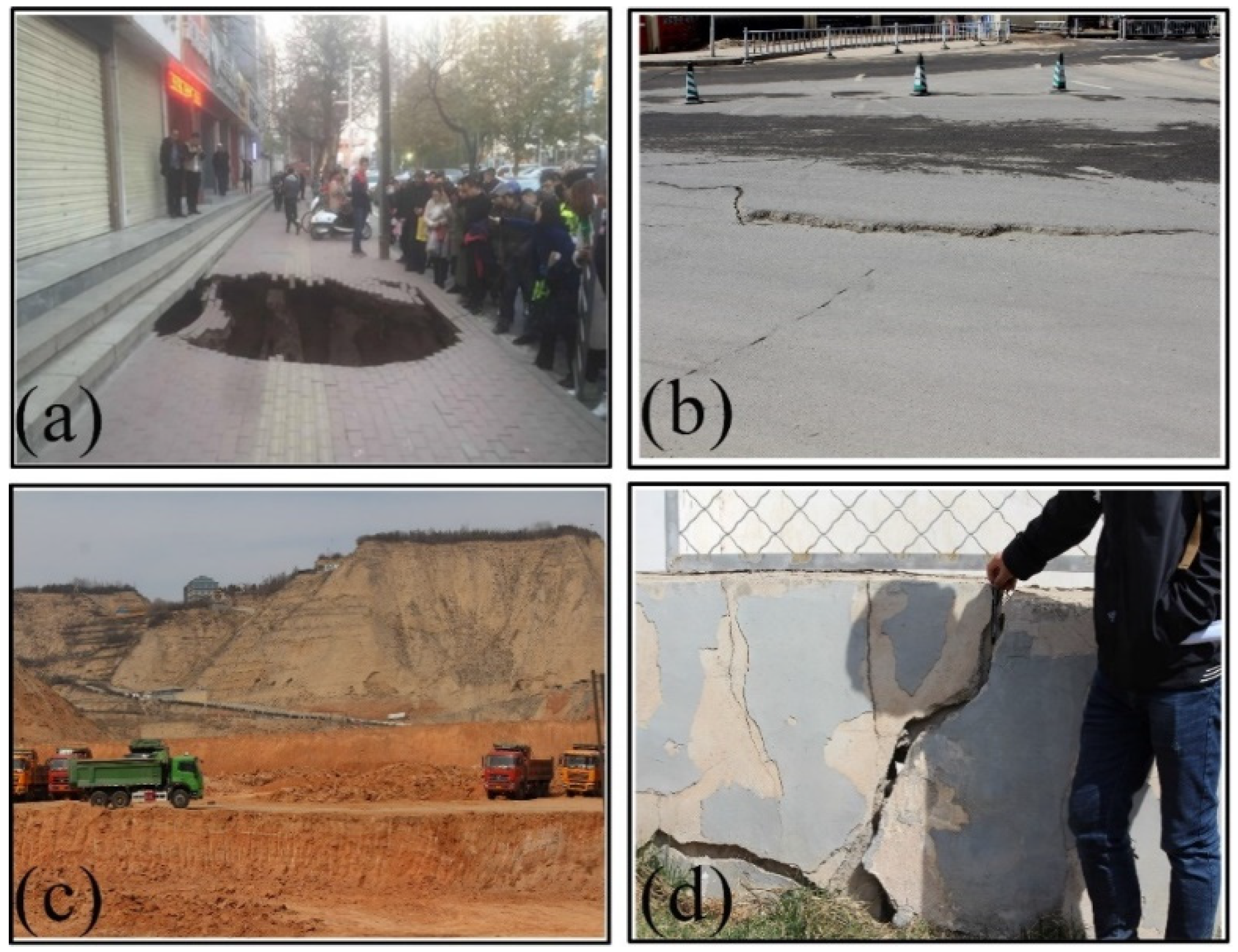
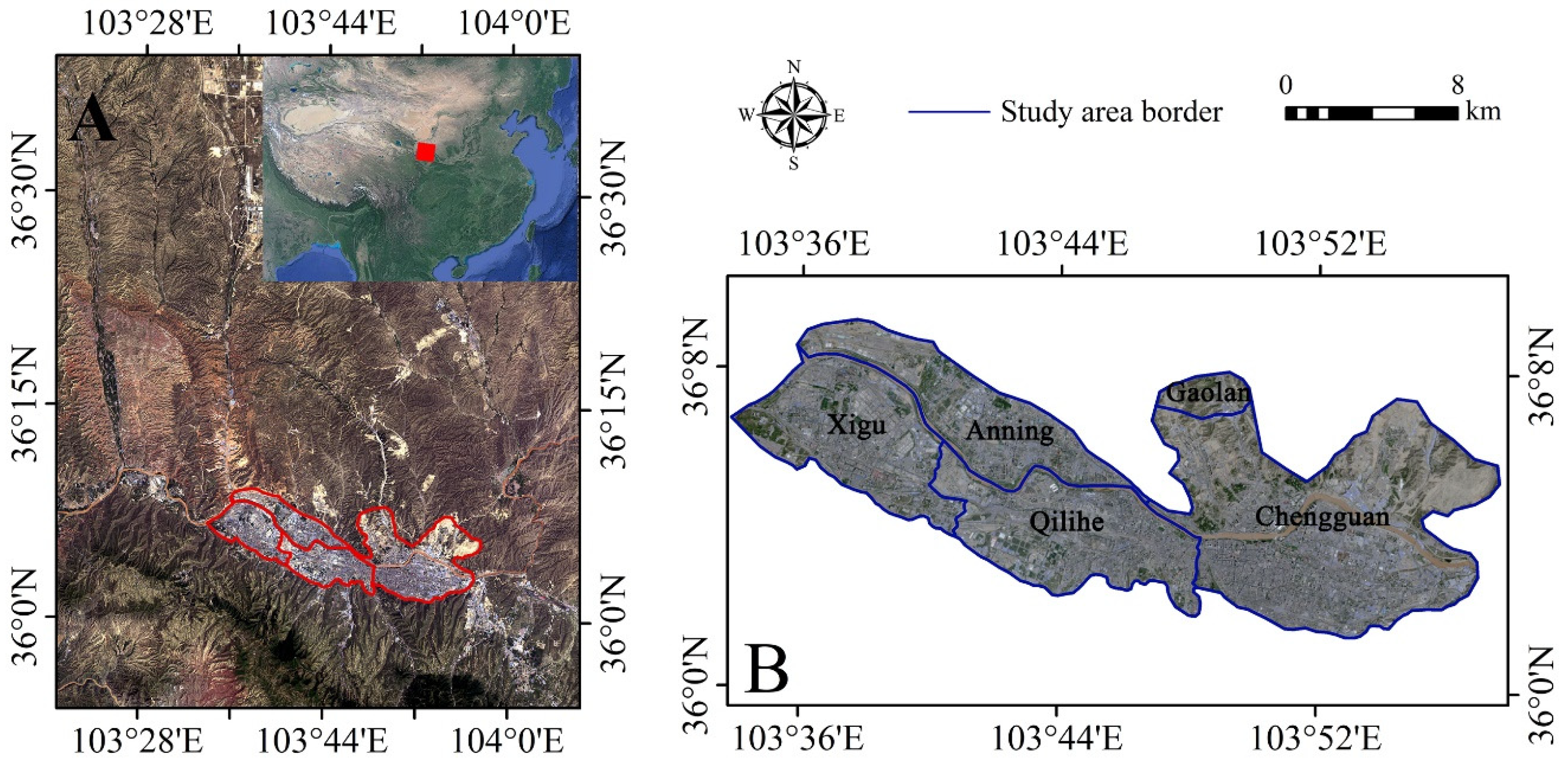

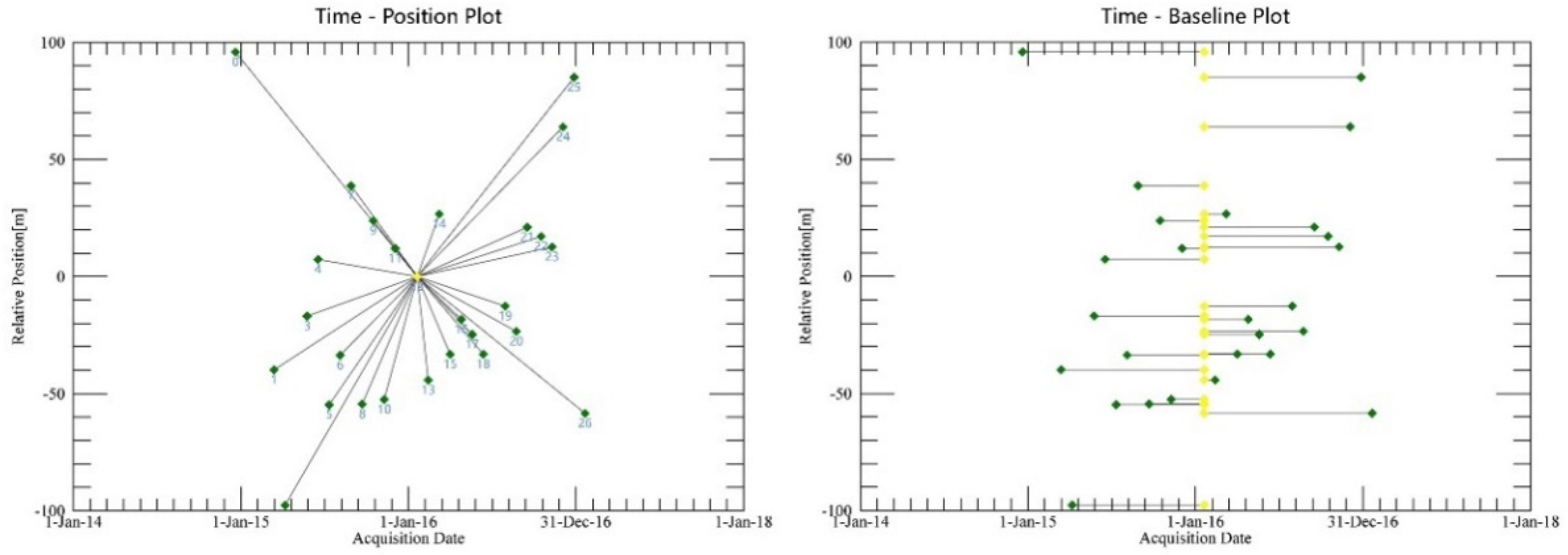
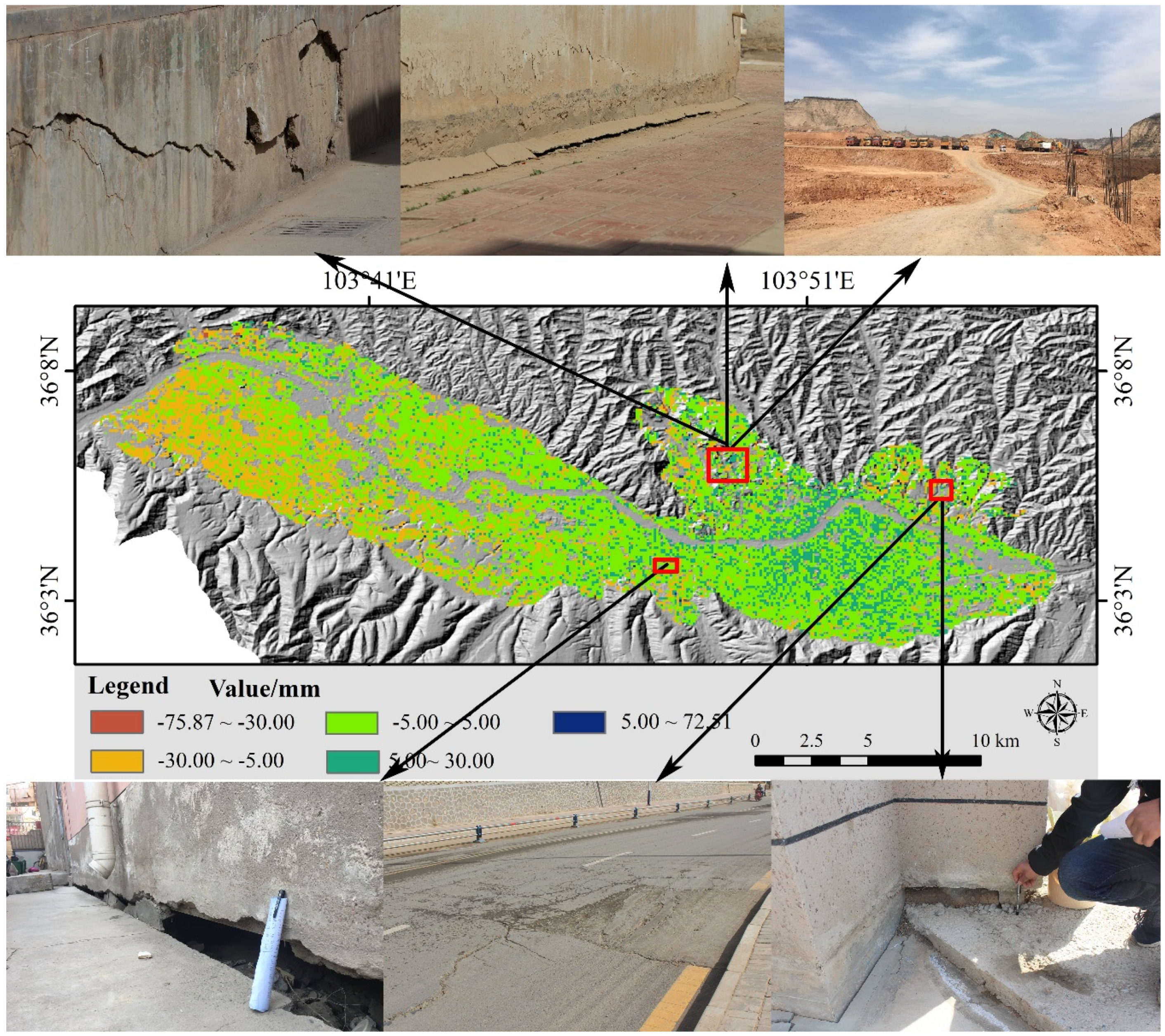

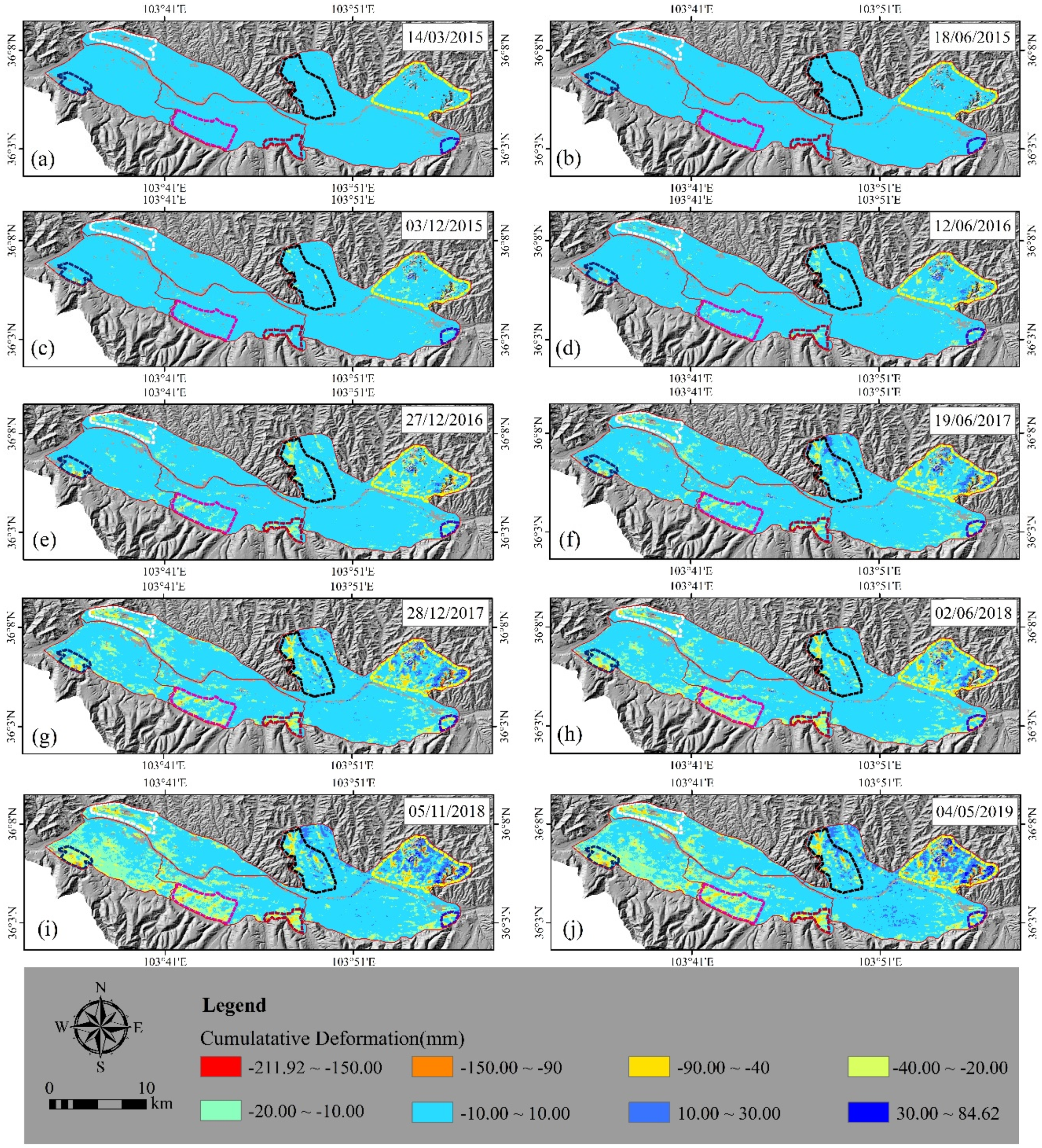
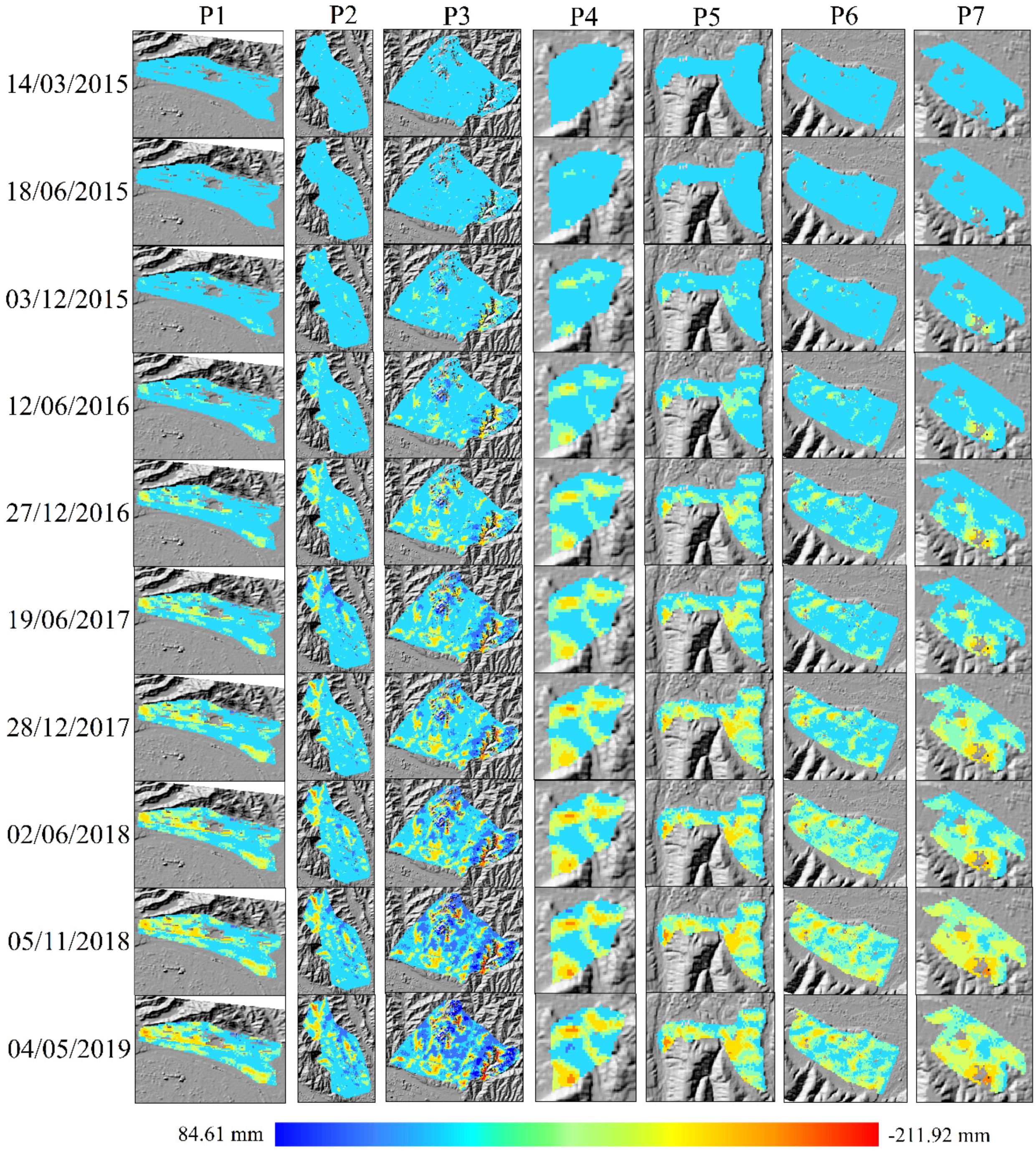

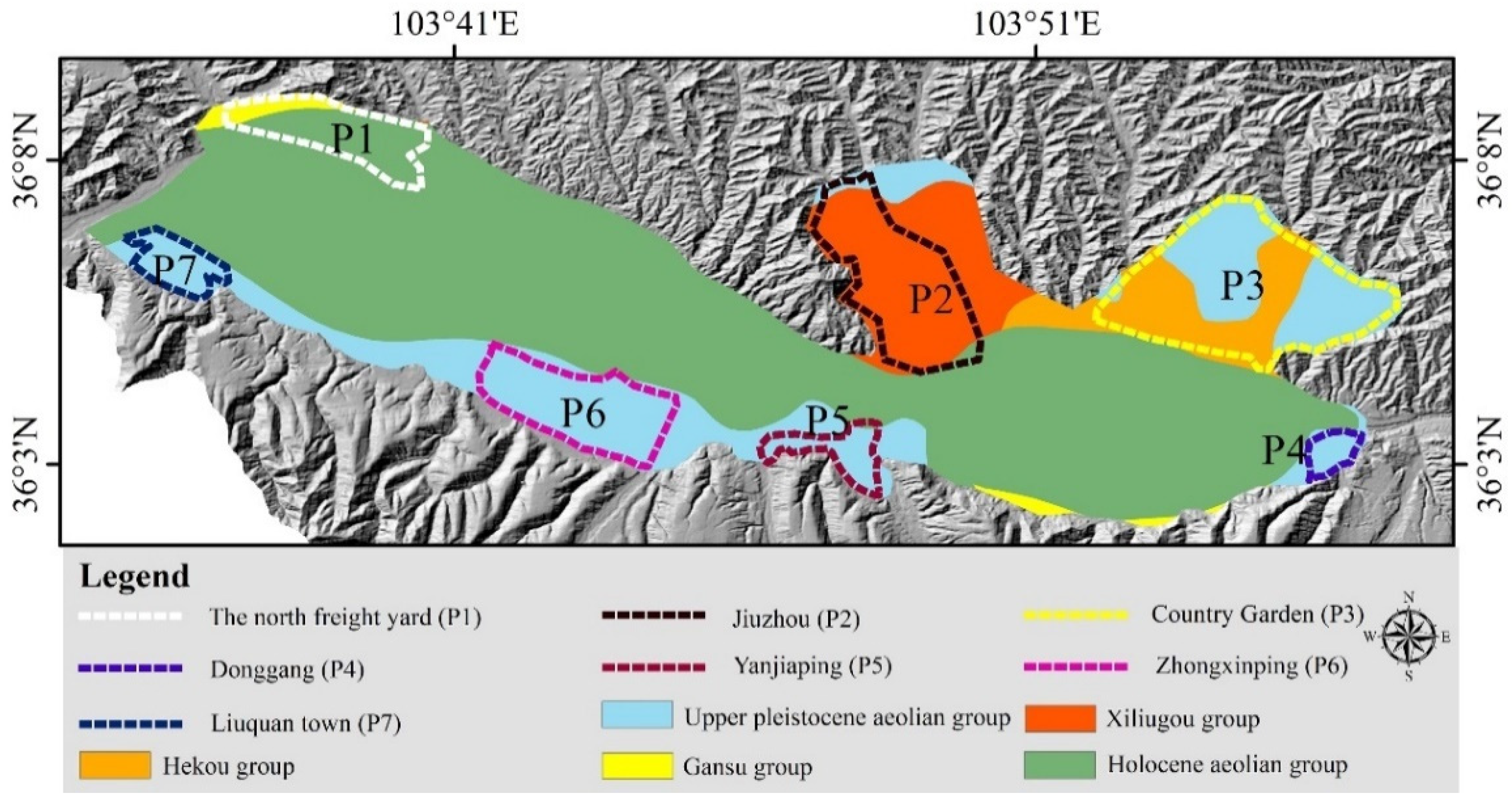


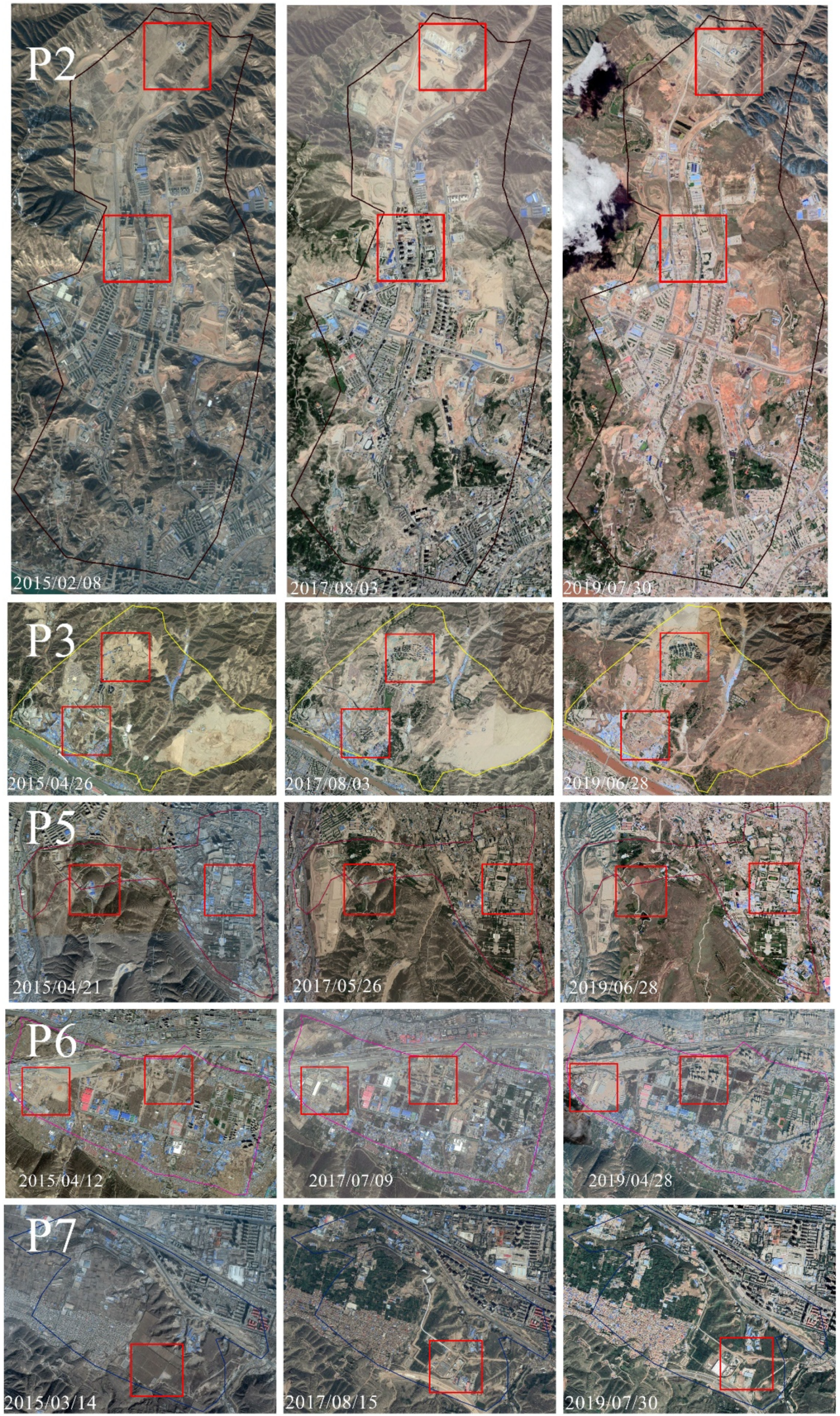
| Acquisition Date | Acquisition Date | Acquisition Date | Flight Direction |
|---|---|---|---|
| 14 March 2015 | 2 November 2016 | 28 December 2017 | Descending |
| 7 April 2015 | 9 November 2016 | 9 January 2018 | Descending |
| 1 May 2015 | 26 November 2016 | 21 January 2018 | Descending |
| 25 May 2015 | 3 December 2016 | 2 February 2018 | Descending |
| 18 June 2015 | 27 December 2016 | 26 February 2018 | Descending |
| 12 July 2015 | 20 January 2017 | 10 March 2018 | Descending |
| 5 August 2015 | 6 February 2017 | 9 May 2018 | Descending |
| 29 August 2015 | 13 February 2017 | 21 May 2018 | Descending |
| 22 September 2015 | 15 March 2017 | 2 June 2018 | Descending |
| 16 October 2015 | 20 April 2017 | 14 June 2018 | Descending |
| 9 November 2015 | 2 May 2017 | 26 June 2018 | Descending |
| 3 December 2015 | 26 May 2017 | 8 July 2018 | Descending |
| 20 January 2016 | 7 June 2017 | 13 August 2018 | Descending |
| 13 February 2016 | 19 June 2017 | 6 September 2018 | Descending |
| 8 March 2016 | 13 July 2017 | 30 September 2018 | Descending |
| 1 April 2016 | 25 July 2017 | 12 October 2018 | Descending |
| 25 April 2016 | 6 August 2017 | 24 October 2018 | Descending |
| 19 May 2016 | 18 August 2017 | 5 November 2018 | Descending |
| 12 June 2016 | 30 August 2017 | 4 January 2019 | Descending |
| 30 July 2016 | 11 September 2017 | 28 January 2019 | Descending |
| 23 August 2016 | 23 September 2017 | 5 March 2019 | Descending |
| 16 September 2016 | 5 October 2017 | 29 March 2019 | Descending |
| 21 September 2016 | 10 November 2017 | 10 April 2019 | Descending |
| 27 September 2016 | 22 November 2017 | 22 April 2019 | Descending |
| 16 October 2016 | 4 December 2017 | 4 May 2019 | Descending |
| Interval Value | Counts | Cumulative Percentage |
|---|---|---|
| −75 | 1 | 0.0049% |
| −65 | 3 | 0.0148% |
| −55 | 0 | 0.0000% |
| −45 | 5 | 0.0246% |
| −35 | 15 | 0.0739% |
| −25 | 67 | 0.3302% |
| −15 | 627 | 3.0902% |
| −5 | 8182 | 40.3253% |
| 5 | 9843 | 48.5116% |
| 15 | 1403 | 6.9147% |
| 25 | 114 | 0.5619% |
| 35 | 15 | 0.0739% |
| 45 | 11 | 0.0542% |
| 55 | 3 | 0.0148% |
| 65 | 0 | 0.0000% |
| 75 | 1 | 0.0049% |
| Locations | Max Deformation (mm) | Correlation with Main Geology | Correlation with Faults | Correlation with Land Cover Types |
|---|---|---|---|---|
| P1 | −115.07 | Holocene Aeolian Group | Fault-limited | Urban |
| P2 | −183.11 | Xiliugou Group | Fault-limited | Urban |
| P3 | −211.92 | Hekou Group and Upper Pleistocene Aeolian Group | Fault-limited | Urban |
| P4 | −132.07 | Upper Pleistocene Aeolian Group | Fault-limited | Industry |
| P5 | −132.54 | Upper Pleistocene Aeolian Group | Fault-limited | Urban |
| P6 | −109.04 | Upper Pleistocene Aeolian Group | Fault-limited | Urban |
| P7 | −142.20 | Upper Pleistocene Aeolian Group | Fault-limited | Agriculture |
© 2020 by the authors. Licensee MDPI, Basel, Switzerland. This article is an open access article distributed under the terms and conditions of the Creative Commons Attribution (CC BY) license (http://creativecommons.org/licenses/by/4.0/).
Share and Cite
He, Y.; Wang, W.; Yan, H.; Zhang, L.; Chen, Y.; Yang, S. Characteristics of Surface Deformation in Lanzhou with Sentinel-1A TOPS. Geosciences 2020, 10, 99. https://doi.org/10.3390/geosciences10030099
He Y, Wang W, Yan H, Zhang L, Chen Y, Yang S. Characteristics of Surface Deformation in Lanzhou with Sentinel-1A TOPS. Geosciences. 2020; 10(3):99. https://doi.org/10.3390/geosciences10030099
Chicago/Turabian StyleHe, Yi, Wenhui Wang, Haowen Yan, Lifeng Zhang, Youdong Chen, and Shuwen Yang. 2020. "Characteristics of Surface Deformation in Lanzhou with Sentinel-1A TOPS" Geosciences 10, no. 3: 99. https://doi.org/10.3390/geosciences10030099





